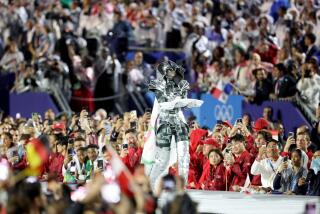Speaking His Mime : Thereâs More That Goes Into His Craft Than White Face Paint, the Master Insists
Mention mime to most people, and a couple of images tend to collide.
If theyâre fortunate, the eloquence of Marcel Marceau at his best takes over--a vision of a white-faced clown performing the beautiful and ineffable.
If theyâre not so fortunate, a picture of a bad street performer settles in the brain waves--a white-faced clown doing the clumsy and annoying.
Marceau, now 65 and for more than 40 years the worldâs pre-eminent pantomimist, realizes he faces that challenge of perception every day. Mime, once a theatrical art form practiced by a handful of silent experts, has become populist, often with discouraging results.
Itâs something that Marceau, who performs Tuesday night at the Orange County Performing Arts Center, tries to accept gracefully but admits that it can get him pretty miffed.
âFrankly, it can be very upsetting because there is a little good street mime and there is much bad street mime,â he sighed during a recent interview, his soft Parisian accent showing some hard edges. âToo many (young people) think all you have to do is put on white face paint and you are a mime. But that is a big mistake.
âThe (subtleties) of technique have to be learned, you have to be a student for a long time. . . . Sadly, it is very possible that the bad ones have hurt the profession. People think, âOh my God, not again!â when they see them . . . and miss the fact that mime, done well, is like nothing else. It is, if I may say, like a special magic.â
Despite his worry that the public may equate all pantomime with what they see on the corner or in a park, Marceau concedes that street performers have generated ongoing interest in the form. By their free face-and-body concerts, they provide advertising for his art--it may be bad publicity, but publicity nonetheless.
In some ways, he points out, it is even flattering. The street mimes are, after all, doing impersonations of Marcel Marceau as much as anything.
Taking an optimistic stance, Marceau draws a parallel between himself and Charlie Chaplin, his lifelong idol and a prime catalyst for his career. When Chaplin first impressed audiences, young men and women would mimic his Little Tramp mannerisms and comic attitudes on city corners. Chaplin was the ideal, and some good comedy resulted from this fanatical interest.
âYou see, when Chaplin did his comedy, there wasnât a kid who didnât do him,â he said. âThat gave him great recognition and (that kind of comedy) great recognition. The imitators didnât hurt Chaplin, and I hope the same is so with Marcel Marceau. Oh, but it is sad when you see the bad Marceau imitators . . . and, of course, (satisfying) when you see the good ones.â
When Marceau talks about himself, it is not with an egotistâs pride of self or accomplishments, but the awareness of what he has meant to mime. It is not exaggeration to say that he has had more influence on the artâs growth worldwide than anyone.
There were mimes before Marceau--he learned his skills from the French master Etienne Decroux--but no other has used television and global tours to present his skills to such a broad audience. Marceau said he has performed in 65 countries, including the Soviet Union, Japan and China, and has toured the United States more than 40 times since 1955.
His prime creation, the alter ego Bip, has reached millions in his silent âmimodramasâ of mortality, joy, cruelty, disappointment, love and longing. America has often provided his most enthusiastic audience--most people were first introduced to him on television, especially his performances with comedian Red Skelton during the â60s.
Before that, he performed in New York (the first time in 1955) and befriended many Hollywood stars, including Groucho Marx, Charles Laughton and Cary Grant. Marceau has appeared in 40 films, mostly small ones for the Encyclopaedia Britannica.
A distinguished and long career. Some critics have said too long, claiming that his talents have diminished with age, and with them the ability to create his wonderful spatial illusions. But Marceau scoffs at the suggestion, saying he works hard to maintain his physical conditioning through yoga, martial arts and various exercises.
âI have remained physically true to my form,â he said. âI am very limber to start with, but I also donât drink or eat junk food and have kept the same weight I had when I was 25. I feel that my body now is as strong as it was when I was 30.
âAlso, you have to look at the form of mime. If I was in classical dance, it would be very difficult (to continue), but mime, while demanding, has such slow movements, ones that you can do if you are fit and have the talent. I also keep (sharp) by performing 300 nights a year.â
He strives to keep it fresh by adding original elements to his tours. At the Center on Tuesday, Marceau said, there will be some of the old--heâll reprise Bipâs famous struggle with the masks--and much of the new.
All in all, there will be eight newer mimes, including a piece he calls âthe eater of heartsâ and describes as a âgruesome Dr. Jekyll/Mr. Hyde sort of tale,â and a finale that employs Bip to figuratively describe Marceauâs own life and âanxiety about the future.â
As for his own future, Marceau plans to put most of his time into creating a national mime company in Paris in conjunction with his international mime college. He has also written a book titled âPimporelloâ--which focuses on an Italian mime and is somewhat autobiographical--that he hopes can be turned into a screenplay.
âIt is the odyssey of growing up as a mime, of living through the worldâs changes from fascist Europe (to the) current day,â he said. âIt tells quite a bit about me but isnât always about me. It reminds me of Bip and me. Yes, itâs a little like Bip.â
Pantomimist Marcel Marceau performs Tuesday at 7:30 p.m. at the Orange County Performing Arts Center, 600 Town Center Drive, Costa Mesa. Tickets: $14 to $28. Information: (714) 556-2787.
More to Read
The biggest entertainment stories
Get our big stories about Hollywood, film, television, music, arts, culture and more right in your inbox as soon as they publish.
You may occasionally receive promotional content from the Los Angeles Times.










